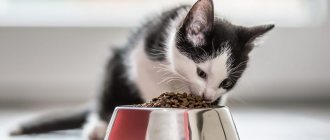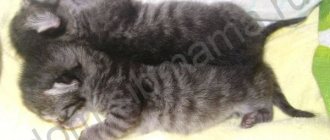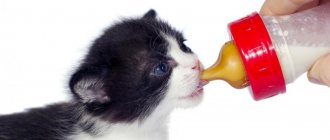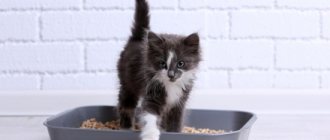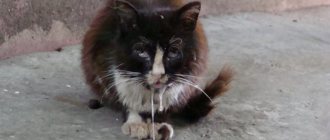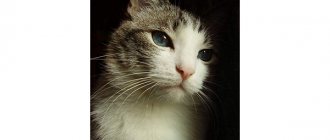The first eight weeks of a kitten's life are a whirlwind of developmental changes. As newborns, kittens are defenseless, blind and fit in the palm of your hand... but by 8 weeks of age they are running, playing and looking like miniature cats.
Each week the kitten will have different needs for feeding, bathing assistance, medical support and warmth. It is important to know how to tell a kitten's age to determine what kind of care it needs and whether it is developing normally. Here's what you need to know about the key developmental stages of a kitten's first eight weeks of life.
Your kitten: newborn
- Physical development : Newborn kittens have their eyes closed and ears folded. They will have no teeth, and their gums, nose and paws may be bright pink. They do not yet have a gag reflex or the ability to thermoregulate. The umbilical cord will be attached and fall off on its own between 4 and 5 days of age. The claws will not extend. At this age they can neither hear nor see; they can navigate the world around them only by smell and by seeking warmth and comfort.
- Behavioral Development : Newborns will sleep most of the day. Newborns cannot defend themselves or walk, but can move around by crawling. A healthy newborn will squirm and meow when picked up.
- Average temperature : 35-36 ℃ at birth. It is important to provide a gentle heat source to keep the kitten warm and stable. The kitten's ambient temperature should be between 30-32 degrees Celsius at this time.
- Average weight : 50-150 grams
- Care Information : Newborn kittens are with their mother at all times, as mothers will provide food, cleaning, warmth, and bath support. If the mother is not present, they should be bottle-fed and kitten formula every two hours under the supervision of knowledgeable persons, encouraged to go to the toilet, and maintained at an appropriate temperature.
© shutterstock
Transition period
This stage begins from the moment the kittens' eyes open and lasts until the animals begin to walk. From about 10 to 15-20 days.
At this time, the kitten begins to hear and see the world around it. In addition, the musculoskeletal system is strengthened, and the kitten begins to walk a little.
The transition period marks the beginning of the kittens' socialization, when they develop attachments to each other and to their mother. At this time, favor and affection for the person is also established. To make a cat tame and affectionate, it is important to gradually establish contact with the kitten. The owner needs to pick up the kitten and caress it, increasing the time from 2-3 minutes at first to 40 minutes daily.
Also during the transition period, the role of the mother as a teacher and controller increases. With the help of games and communication, she regulates the behavior of kittens, teaches them the basics of hunting and interaction with the outside world. The owner can also take part in this process. It is important to introduce your kitten to new smells and sensations through toys and other safe objects.
Your kitten: week 1
- Physical Development : Week-old kittens will have closed eyes but no umbilical cord. They won't have teeth anyway. The claws will still not extend. After about 7 days, the ear canals will begin to slowly open and the ears will open slightly. Between 8 and 12 days, the eyes will begin to slowly open, which may occur over a period of several days. One eye may open faster than the other. It is important that the kitten's eyes open at a pace that is comfortable for him. All kittens will be born with blue eyes, which will develop into adult eye color as they age.
- Behavioral Development : One-week-old kittens, although larger than newborns, will still be largely uncoordinated and sleep most of the day. At this age, they should be able to hold their head up, move around by moving their limbs, and be active and vocal when held.
- Average temperature : 36-37 ℃. It is important to provide a gentle heat source to keep the kitten warm and stable. At this time, the kitten's ambient temperature should be about 26 degrees.
- Average weight : 150-250 grams. By 1 week of life, the kitten should approximately double its birth weight.
- Care information : Week-old kittens belong to their mother permanently. If the mother is not present, they should be bottle-fed and kitten formula every two to three hours by a knowledgeable caregiver, encouraged to go to the toilet, and maintained at an appropriate temperature.
Your kitten: 2 weeks
- Physical Development : At 2 weeks of age, kittens' eyes will be fully open and blue. They will have poor eyesight and will not be able to see over long distances. The ear canals will be open, and the ears will be small and round, like a bear cub. If you open the kitten's mouth, you will find that there are still no teeth. The claws will still not extend.
- Behavioral development : Two-week-old kittens will become more coordinated and begin to take their first steps. They will be unsteady on their feet and uncoordinated. Kittens at this age may be curious about the world around them, will not yet play and will spend most of their time sleeping.
- Average temperature : 36-37 ℃. It is important to provide a gentle heat source to keep the kitten warm and stable. At this time, the kitten's ambient temperature should be about 26 degrees.
- Average weight : 250-350 grams
- Care information : Two-week-old kittens live permanently with their mother. If the mother is not present, they should be bottle-fed and kitten formula every three to four hours by a knowledgeable caregiver, encouraged to go to the bathroom, and maintained at an appropriate temperature. Kittens as young as two weeks old may begin to develop degwords.
General information about fold-eared breeds
The history of the breed began in 1961, when an unusual white cat, Susie, was discovered on a farm in Scotland. The tips of her ears were bent forward and covered the upper part of the ear canal.
Susie later gave birth to kittens, two of which (a boy and a girl) inherited a genetic ear abnormality from their mother. The cat was castrated, so he did not leave offspring. And a cat named Sans was purchased by William Ross, who lived next door.
Ross brought geneticist Pat Turner into the matter and the two of them began breeding a new breed. Local British cats were used as partners for Sans, and as a result, 76 kittens were born. Of these, 42 were born with fold ears, and 34 with ordinary ears. This was enough to write an application for the creation of a new species. But life made its own adjustments.
In 1971, the registration of fold-eared cats was canceled. The animals exhibited diseases of the bones, spine, deformities of the limbs, deafness, a tendency to infectious diseases, and much more. It is possible that the story of the Scots could have ended there, but the situation was saved by geneticists from the USA. The problem was solved quite simply. All diseases turned out to be a legacy of the connection between homozygous cats (having the same alleles for lop-earedness). As soon as they began to be bred with straight-eared Scots (heterozygous), healthy kittens were born.
In 1978 the CFA gave the Scots show status. It took another 15 years to establish the standard of the new breed, which was called the Highland Fold (the first cats were long-haired). Later, shorthaired fold and straight-eared Scottish cats were recognized. They became Scottish and Highland Straights.
Your kitten: 3 weeks
- Physical Development : At 3 weeks of age, kittens will have blue eyes and small ears that begin to point upward, like a miniature cat. The kitten's vision and hearing will gradually improve. At this age, the kitten begins to erupt its first teeth. The tiny teeth at the front of the mouth, called incisors, will begin to come through the gums. The kittens will gradually begin to retract their claws.
- Behavioral Development : At this age, kittens will wander around, explore their surroundings, and even begin to explore the litter box. They may begin to be interested in cat toys, although they may not yet be able to run or chase moving objects. They will sleep frequently and may begin to engage in small grooming behaviors. During this week, their coordination will improve quickly.
- Average temperature : 37-38 ℃. Three-week-old kittens still need a source of warmth, but they will be more active and may stray away from it when they are not sleeping. The kitten's ambient temperature at this time should be about 23 degrees.
- Average weight : 350-450 grams
- Care information : Three week old kittens live permanently with their mother. If the mother is not present, they should be bottle-fed and kitten formula every four to five hours by an experienced caregiver. Add a shallow litter box with non-clumping litter.
© shutterstock
Features of development in the first week
Kittens develop especially rapidly in the days after birth. After birth, he weighs no more than 100 grams and gains about the same amount in the first week. Underweight or excess weight directly affects development, so you need to monitor it and regularly weigh your pet.
During the first 3 days of life, as a rule, the umbilical cord falls off, which the cat can care for independently. But in order to prevent the occurrence of inflammation, kittens are recommended to treat the umbilical cord in the first days of life with a weak solution of potassium permanganate.
A newborn kitten is always blind and begins to see only after three weeks from birth. Few people know such a feature as congenital deafness, which disappears only by 5 days after birth. A deaf baby does not even respond to his mother's voice.
It is especially important to arrange a place for the cat in advance so that small kittens during the period of deafness can easily find their mother . The development of kittens from birth occurs very rapidly; it is during this period that he receives his first food in the form of mother's milk, which ensures that all necessary microelements and nutrients enter the body. Natural nutrition is very important for the development of a kitten, since it also includes antibodies that the baby needs to form immunity.
© shutterstock
Although the baby does not see or hear in the first days of his life, he perfectly uses his sense of smell, with the help of which he identifies his mother. Kittens are born with a sense of smell that allows them to find a cat, even if it is within a radius of 60 centimeters from the kitten. In order to ensure the proper development of the kitten, it is necessary to prepare a place for the cat in which drafts and sudden changes in temperature will be completely excluded. This will not only protect the baby from colds, but also provide comfortable conditions for growth.
Your kitten: 4 weeks
- Physical development : At 4 weeks of age, kittens' vision and hearing will improve significantly. The kitten's teeth will continue to develop. The long teeth next to the incisors, called canines, will begin to extend through the gums. The claws will be retractable.
- Behavioral Development : Four-week-old kittens will confidently learn and develop coordination that allows them to walk, run, and even begin to play. With enhanced senses, they will be noticeably more responsive, making frequent eye contact with caregivers and reacting to sights and sounds in the environment. Their caregiving skills may be limited, but they are improving. They will use a litter box.
- Average temperature : 37-38 ℃. Continue to provide a source of heat for 4-week-old kittens, although they will likely only use it when resting. The kitten's environment should be comfortably warm and should never be below 21-23 degrees Celsius.
- Average weight : 450-550 grams
- Care information : Four-week-old kittens belong to their mother. Orphans this age should be bottle-fed every five hours, including at night. Four-week-old kittens will usually use a litter box and can be trained to use toys.
How many months is a kitten considered to be?
Experts agree that a cat becomes an adult at the age of 1 year. As you approach this age, you will notice a change in many factors:
- teeth will be completely replaced;
- character will be fixed, like most habits;
- a developed hunting instinct, which he often uses;
- outwardly looks like an adult animal, movements are smooth, graceful;
- a period of puberty will pass (fickle mood, loss of appetite, cats marking their territory, and cats going through their first heat).
An adult cat is no less a responsibility for the owner. But congratulations, you have already passed the main stage! The cat's body is fully formed and the active growth phase is completed. Then there are questions about castration, suitable food, combing...
Source
Your kitten: 5 weeks
- Physical development : At 5 weeks of age, the kitten's teeth continue to develop. The premolars will begin to emerge. The eyes will be blue, and the ears will grow and become pointed. The claws will be retractable.
- Behavioral Development : Five week old kittens will run and play confidently. They will develop communication skills with people and other animals. Their self-care skills will improve. By this age, they will have perfected their use of the litter box.
- Average temperature : 37-38 ℃. At this age, a heat source is no longer required if the environment is at a comfortable temperature of 21-23 degrees.
- Average weight : 550-650 grams.
- Care Information : Five week old kittens, if healthy, can begin the weaning process. Kittens should be given adequate amounts of "liquid manure" or wet kitten food, in addition to their mother's milk or bottle if they are orphaned. If weaning occurs, food and water should be provided at all times. Always provide supplemental nutrition and ensure the kitten maintains a healthy weight and body shape during weaning. Always provide a shallow litter box.
What to feed your baby
An unsuccessful birth can lead to problems with lactation for your cat. But the kitten needs to develop physically, so in this case you need to take its feeding into your own hands. For this purpose, there is a cat's milk substitute - nutrition adapted in composition, close to mother's milk. It contains all the necessary components for your kitten to gain weight and stay healthy.
To calculate the amount of feeding there is a simple formula: 7 teaspoons of formula per day, meals every two hours.
Your kitten: 6 weeks
- Physical Development : At 6 weeks of age, a kitten's teeth begin to reach the final stage of early development. The molars will begin to appear. The eyes will still be blue, and vision and hearing will be fully developed.
- Behavioral Development : Six-week-old kittens will confidently interact with peers, fight, attack and defend themselves. They will be curious about their surroundings and will be eager to explore. They will improve their self-care skills. At six weeks old, kittens become coordinated enough to jump off furniture and land on their feet.
- Average temperature : 37-38 ℃. At this age, a heat source is no longer required if the environment is at a comfortable temperature of 21-23 degrees.
- Average weight : 650-750 grams.
- Care Information : Kittens should receive adequate amounts of wet food after weaning. Always provide access to water, food and a shallow litter box. At six weeks, kittens should receive their first FVRCP vaccine to protect against viruses (rhinotracheitis, calicivirus and panleukopenia).
© shutterstock
Juvenile period
The juvenile stage begins at approximately 11 weeks and lasts until puberty, which is four to five months. The kitten becomes hyperactive and curious. The owner’s task is to ensure his safety during this period. At the age of three months, the kitten has excellent spatial orientation, knows its name, is litter box trained and is independent of its mother. This means that this is the best time to transfer it to new owners.
The development of kittens by week ends at approximately three months. Further maturation slows down. At this time, the muscle corset is strengthened and the teeth are finally replaced. The period of puberty begins. Cats become adults at about one year of age.
Your kitten: 7 weeks
- Physical Development : All baby teeth will appear by 7 weeks of age. At this age, the kitten's eye color will change and the adult eye color will begin to appear. Kittens' testicles will begin to descend at about 7 weeks.
- Behavioral Development : Seven week old kittens will experience a burst of energy. Sleep will decrease and time spent playing will increase. At this age, kittens can run, climb cat trees, and confidently jump off furniture.
- Average temperature : 37-38 ℃. At this age, a heat source is no longer required if the environment is at a comfortable temperature of 21-23 degrees.
- Average weight : 750-850 grams.
- Care Information : Kittens should receive an adequate amount of wet kitten food and may have dry kitten food as a supplement. Always provide access to water, food and a shallow litter box.
Feeding methods
Kittens at the age of two weeks need to be fed correctly. You cannot turn the kitten over on its back. Place your fluffy on your lap on a disposable diaper. Lift your muzzle slightly by the scruff of the neck.
It is best to use a container or box with low sides. Cover the bottom with a soft cloth. Place the kitten's front legs on the bottom, but so that his front paws rest against the side. Over time, the kitten will choose a comfortable position for eating.
Important! After eating for up to 3 weeks, kittens burp. Therefore, before the massage, place the kitten on your chest and stroke its back for a few minutes until it burps.
It is best to feed babies from bottles with a nipple or pipette. This way the milk supply will be delivered evenly or drop by drop. If your kitten has a weak sucking reflex or is having difficulty sucking formula from a bottle, use a dropper.
Your kitten: 8 weeks
- Physical Development : All baby teeth will appear by 8 weeks of age. The eyes will completely change to their adult color - green, yellow, brown or blue. The ears will be proportional.
- Behavioral Development : Eight week old kittens will be energetic and independent. Their agility and coordination will be almost fully developed.
- Average temperature : 37-38 ℃. At this age, a heat source is no longer required if the environment is at a comfortable temperature of 21-23 degrees.
- Average weight : 850-950 grams.
- Care Information : Kittens should be fed canned and dry kitten food three to four times daily and can get the bulk of their calories from dry food if they choose. Always provide access to water and a shallow litter box. If two weeks have passed since the first FVRCP vaccine was administered, kittens can receive a booster vaccine at this time. If the kitten has not been dewormed, a dewormer can be administered. It's also a good idea to do a stool test to check for internal parasites. At this age, if they weigh about a kilogram and are healthy, they can be spayed/neutered, microchipped and adopted.
Stages of kitten development by month
When kittens open their eyes: how many days after birth
Once born, kittens grow and develop during the first year of life. “Coming of age” in cats occurs at 12 months. At each stage of growth, the baby requires appropriate care: nutrition, weight control, medical examination, vaccinations, etc.
Stages of development:
- Prenatal period - during the cat's pregnancy.
- Neonatal - from birth to 10 days.
- Transitional - from the 10th to the 20th day of life.
- The period of socialization is from the third to the tenth week of life.
- Juvenile - at 2.5–5 months.
- Puberty occurs between 5 and 12 months.
Immediately after birth, every day of the baby’s life is of great importance. Starting from the age of 7 days, the count goes into weeks. When the baby reaches the age of 2 months, developmental stages are counted in months. A six-month-old kitten can already be called a teenager. He continues to grow and develop rapidly and becomes an adult cat closer to the age of one year.
First 7 days of life
You need to take care of the health of kittens when they are still living in the womb. A pregnant cat needs to be well fed and protected from stress. It is advisable to equip her with a warm nest where she can rest. A year before pregnancy, the cat must be vaccinated.
Week-old babies are growing rapidly
Kittens are born blind and deaf. Each baby weighs about 60–100 grams. At this time, the baby’s nervous system continues to form. For the first 7–10 days of life, they sleep and suck their mother's milk. In the first three days, babies receive colostrum - a nutritious fluid containing antibodies to all diseases.
For your information! Colostrum is unique and irreplaceable: with it, kittens receive not only food, but also their first vaccination. It is very important that babies eat colostrum: it strengthens their immunity.
The mother cat spends all the time with her children, only leaving occasionally to eat. In the first days after birth, kittens navigate only by smell and touch: they can find their mother at a distance of 60 cm. They can squeak, and a little later they learn to purr.
Newborn kittens have reflexes responsible for their vital functions:
- Sucking - allows you to feed on mother's milk. If this reflex is impaired, the kitten may die.
- Perineal - responsible for urination and defecation. To stimulate it, the cat licks the kittens' tummies. If the babies are orphaned, then this should be done by the owner who feeds the pets.
- Cover reflex.
The kitten begins to hear 5-8 days after birth. But despite this, he still does not know how to navigate by sound. It is necessary to place the kittens in a quiet room so that they are not frightened by noise.
If a kitten refuses to suckle breast milk, he needs to be given an injection of Gamavit or Aminovit. You can put 2 drops of Travmatin in your mouth.
Week-old kittens eat only their mother's milk. At this age, they already hear, but do not see yet. They must be weighed twice a day and weight gain must be constantly monitored.
Important! Violation of the sucking reflex is a condition that threatens the life of the baby. A common cause of this is a cleft palate (cleft palate). The kitten tries to suckle, but the milk pours out through the nose. In such cases, the baby is most likely doomed.
Second week of life
On the 10th or 14th day of life, kittens' eyes open. At this age, all babies have blue eyes. Their color changes closer to 3 months.
Kittens at 2 weeks weigh almost twice as much as at birth - about 200–250 g. You need to carefully monitor their diet and weight. At this age, they still feed on their mother’s milk and need her care.
Two-week-olds open their eyes and ears
You can see how adult cats trample a soft blanket with their paws and purr. This indicates that the cat is happy and content. This reflex has been preserved since childhood, when newborn kittens knead their mother’s belly to get milk.
Third week of life
The musculoskeletal system of kittens gradually strengthens, and three-week-old babies become more active: they begin to crawl over each other and begin to play. Closer to the 20th day of life, kittens stand on 4 legs and try to walk. Their weight increases to 250–350 g. At the same time, they begin to teethe.
Kittens develop a feeling of attachment to their mother and to each other. In the same way, they become attached to the owner. The cat begins to teach the kids.
Fourth and fifth weeks of life
At the age of 1 month, the kitten moves confidently, sees and hears well, and loves to play. He has already grown 26 baby teeth, which will be replaced with permanent ones over the next 6 months. It is necessary to introduce complementary foods into their diet: canned food for kittens, boiled meat, cottage cheese. Kids learn to lap up water or milk from a saucer. The weight of a one-month-old kitten is 350–450 grams.
The period of socialization begins when the baby learns to interact with the world around him: with his mother, with brothers and sisters, with toys, with owners, with household objects. At this age, small cats are very active and playful. The owner must take care of the safety of pets.
At 1 month, kittens know how to wash themselves and love to play.
At 5 weeks, kittens can wash themselves and go to the litter box. Gradually they switch to solid food and drink breast milk much less often. They need to be weighed every day.
Two months of kitten life
A mother cat feeds her babies with breast milk for up to 2 months. Then they completely switch to the adult diet. Babies vitally need the whole complex of vitamins and minerals. At the age of 8 weeks, you need to take the kittens to the veterinarian so that he can prepare a diet for them, drive away worms and give them vaccinations. 3 weeks after the first vaccination, they are vaccinated again: this will protect the animals’ immunity for a long time.
Two-month-old kittens need to be petted and stroked frequently. During this period, their behavior changes and more activity appears. They will need toys and space to run and play.
Interesting fact! Boys grow faster than girls.
Three months of kitten life
Up to three months, the development of kittens varies from week to week. At this age, the claws become stronger and the weight reaches 1.3–1.5 kg. Blue eye color changes to green, yellow, amber or any other color that will remain forever. Bones, muscles, joints and tendons become stronger and stronger, so pets can run and jump for a long time. Kittens become independent, so at 3 months they can be separated from their mother and placed in good hands.
A three-month-old kitten comes up with different games and fun. He can climb up curtains, play with any objects, run and jump. It is very important that the owner finds mutual understanding with a child of this age. Both the upbringing and safety of your furry pet depend on this.
At 2 months the first vaccinations are given
A caring owner should know what to feed a 3-month-old kitten. Special food for kittens is perfect. You can give boiled meat, cottage cheese, pates. Babies are fed 5-6 times a day, a single serving should be 100 g.
Fifth month
At this age, permanent teeth grow in place of baby teeth. Favorite fluffies gain weight up to 1.8–2 kg. They need to be fed 4-5 times a day and weighed weekly. It is advisable to combine dry and wet food intended for kittens up to one year old.
Sixth month
In six-month-old animals, hormonal levels change and the process of puberty begins. They reach the size of an adult animal. It is necessary to give the kittens an anthelmintic again and take them to the veterinarian.
At this age, you can switch your pets to three meals a day. It is still necessary to feed babies baby food, because it contains many useful substances that a growing body needs.
Table No. 1. Kitten weight by week (medium sized cats)
| Age | Weight |
| Newborns | 70–130 g |
| 1 Week | 140–285 g |
| 2 weeks | 225–400 g |
| 3 weeks | 285–500 g |
| 1 month | 500–750 g |
| 2 months | 1–1.5 kg |
| 3 months | 1.7–2.3 kg |
| 4 months | 2.5–3.6 kg |
| 5 months | 3.1–4.2 kg |
| 6 months | 3.5–4.8 kg |
After six months, the growth rate slows down slightly, and kittens gain an average of 100 g per week.
Seventh month
At 7 months, kittens begin to molt. At this time, it is necessary to comb the coat every day with a furminator or comb. Cats that shed often lick themselves, which causes fur to get into their stomachs, causing them to vomit. The formation of hairballs in the stomach is extremely dangerous, so cats need to be combed.
Attention! Timely vaccination will save kittens' lives.
After 3 months and before the first vaccination, babies' immune systems weaken, so they can become infected with an infectious disease. If your kitten's eyes are festering, or if he has become lethargic, you should immediately contact a veterinary clinic.
Eighth month
By this age, kittens have already grown enough and look like adults. Animals need to be sterilized at 8 months. You must first be examined by a veterinarian. An animal can be sterilized no earlier than a month after vaccination.
At 3 months, eye color changes, you need to switch to adult food
Development from 9 months to a year of life
This is the final period of childhood. Young cats at 9–12 months do not grow as quickly as before. Active, curious, playful pets still love to run and frolic.
Height, weight and development depend on the size of the animal, including the breed. It is necessary to take these nuances into account. The breed, which came to us from Scotland, has several distinctive features. The most noticeable of these is the floppy ears. All Scottish cats are born with straight ears. Only 18–20 days after birth can fold-eared kittens be recognized.
Big cats - British and Maine Coons - weigh a little more than others.
Table No. 2. Weight of Maine Coons, Scottish and British kittens by week
| Age | Maine Coons | British | Scottish |
| Newborns | 120–160 g | 60–140 g | 60–140 g |
| 7 days | 180–260 g | 110–260 g | 110–260 g |
| 2 weeks | 280–360 g | 150–400 g | 140–400 g |
| 3 weeks | 420–600 g | 210–630 g | 200–630 g |
| 1 month | 560–750 g | 250–740 g | 240–740 g |
| 2 months | 1.1–1.5 kg | 450–1700 g | 400–1700 g |
| 3 months | 1.7–2.3 kg | 1–2.5 kg | 1–2.5 kg |
| 4 months | 2.7–3.8 kg | 1.7–3.9 kg | 1.7–3.9 kg |
| 5 months | 2.9–5.5 kg | 2.2–4.3 kg | 2.2–4.3 kg |
| 6 months | 3.2–6 kg | 2.3–5.4 kg | 2.3–5.4 kg |
| 7 months | 3.5–6.5 kg | 2.4–5.6 kg | 2.4–5.6 kg |
| 8 months | 3.8–6.9 kg | 2.5–6 kg | 2.5–6 kg |
| 9 months | 4.1–7 kg | 2.5–6.4 kg | 2.5–6.4 kg |
| 10 months | 4.2–7.7 kg | 2.5–6.7 kg | 2.5–6.7 kg |
| 11 months | 4.3–8 kg | 2.5–6.8 kg | 2.5–6.8 kg |
| 1 year | 4.5–9 kg | 2.5–7 kg | 2.5–7 kg |
